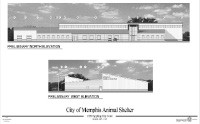Charlie, a tan German shepherd mix, wants a treat. A man is dangling a bone-shaped dog biscuit in front of his face, and Charlie is doing everything to prove he’s worthy. When the man asks him to sit, he does so, longingly gazing at the treat with his piercing light-brown eyes.
Then Charlie lies down without being asked, as if to say, “See, I know this trick too.” Finally, the man concedes, and Charlie eagerly takes the treat. He looks like he could use a few more. His ribs are showing through his short, tan coat.
Charlie was adopted from Memphis Animal Services (MAS) once before, but his new owner returned him. Now, he’s showing off in the brightly colored doggie visitation room at MAS. Charlie is probably hoping he’s going home with the man with the treat, but unfortunately for him, that man is Flyer photographer Justin Fox Burks, and he already has enough dogs at home. Charlie is still up for adoption at MAS.
He’s one of hundreds of dogs, cats, and the occasional horse or chicken that come through the shelter each month. Fortunately for Charlie and the rest of the animals, conditions have improved somewhat since the city hired interim shelter director James Rogers in February 2012 and since the animals from the old, worn-down animal shelter on Tchulahoma were moved into the new facility on Appling City Cove.
Euthanasia rates are down. Adoption rates are up. The staff seems friendly as they greet guests who walk in the door. The building even smells pretty nice, considering that it’s home to hundreds of animals. The whole place has a happier feel to it compared to the old shelter, which was a haven for airborne animal disease.
But the shelter has always had its share of tough critics. Animal advocates have been watching Rogers’ every move since day one. Some recognize that a few improvements have been made, but they’re vocal about the problems that still exist.
At a recent MAS advisory board meeting at the Benjamin L. Hooks Library, animal advocates raised concerns about unanswered calls by animal control officers, kennel beds that are falling into disrepair, and a state-of-the-art veterinary clinic that isn’t being used to its full advantage. Many of the shelter reform advocates continue to push for MAS to become a no-kill facility.
“I say to the critics, continue to voice your opinion,” Rogers said. “I need it. It helps me fix some of the things I haven’t seen, some the weaknesses, some of our flaws. With their help, we can become the world-class facility that we want to be.”
History of Abuse
The shelter critics have good reason to be concerned. MAS has a history of problems. Perhaps the most egregious situation occurred in October 2009, when the Shelby County Sheriff’s Office raided the shelter and discovered animals were being starved to death. Former shelter director Ernie Alexander and two employees, shelter supervisor Tina Quattlebaum and veterinarian Angela Middleton, were arrested on charges of animal cruelty (Middleton was acquitted last October, but Alexander and Quattlebaum are still awaiting trial).
After the raid, Mayor A C Wharton hired Matthew Pepper to lead the shelter. And although Pepper made some improvements, he failed to turn the shelter around. Pepper resigned in August 2011, not long after animal control officer Demetria Hogan was arrested on cruelty charges when one pit bull died in her care and another, Kapone, went missing for months (He was later found in Senatobia, Mississippi, and reunited with his family in Cordova). Hogan has yet to be tried in that case.
Around the same time, the Memphis Rotary Club did an independent investigation into shelter operations and interviewed several employees, who admitted that some of their co-workers were involved in dog-fighting.
When the shelter was between directors — from November 2011 to February 2012 — undercover Memphis police officers observed shelter employees Archie Elliot, Frank Lightfoot, and Billy Stewart abusing animals in the euthanasia room. In one case, Elliot was seen lifting a dog that was scheduled to be euthanized off the floor by its leash and choking it by letting it dangle over a sink.
Elliot was sentenced to two years behind bars for hanging and choking dogs, while Lightfoot, who was observed stomping on cats, was given 20 days in prison and 23 months of probation. Stewart still awaits trial.
A New Leaf
In late February 2012, Wharton appointed retired U.S. Postal Services manager James Rogers to lead MAS in an interim role. Although his position is still technically temporary, the city has put the search for a permanent director on hold.
“Mr. Rogers came in carte blanche with no previous animal administration experience, but what he had was a sense of auditing, a sense of constant supervision,” said Steven Tower, a veterinarian and the chair of the MAS advisory board. “He was able to take that template of what it takes to get a piece of mail delivered positively every time and apply it to making sure his kennel workers are checked on a regular basis. There’s constant auditing and supervision going on, and I think that’s where Rogers fits in.”
He was hired shortly after the city erected a new multi-million-dollar shelter facility, complete with cat and dog socialization rooms and a state-of-the-art ventilation system.
“Coming in and seeing all the news reports concerning the shelter and the way the animals were treated, it was clear to me that we had a training issue,” Rogers said. “It was clear that there was an issue of leadership and an issue of holding employees accountable. Those things coupled with the findings in the Rotary Club report helped me identify some of the weaknesses and to make sure it’s run correctly.”
Rogers instituted training sessions on animal feeding and care, kennel cleaning, and other areas with help from the Humane Society of the United States. He installed a system of supervision to oversee workers in all areas of the shelter.
“Every supervisor and manager walks through the shelter with logs and identifies things they see wrong. A technician comes behind and looks at the logs and eliminates deficiencies,” Rogers said.
The old shelter not only had a bad reputation for dogs dying of airborne diseases, such as distemper. While under Pepper’s leadership, a distemper outbreak at the shelter led to dozens of animals being euthanized. The new building features a better ventilation system.
The new facility is also much cleaner. “The conditions are more sanitary, and the kennels are much cleaner. In the old shelter, you’d walk through, and it was so dirty that you’d want to start crying,” said Jody Fisher, who helps find homes for shelter dogs.
But despite a healthier animal population, a cleaner facility, and better supervision, the shelter still suffers from an image problem. The new facility certainly helps, but Rogers felt that some rebranding was in order, so he found an artist to redesign the MAS logo through a public contest last year.
“We are trying to rebrand ourselves and leave our negative image behind. We offer new and better services, and we have better outreach,” Rogers said.
MAS recently began participating in an American Society for the Prevention of Cruelty to Animals-sponsored trap/neuter/release program for cats, through which volunteers catch feral cats, have them neutered in the shelter’s vet clinic, and release them back into the wild.
Rogers hired a groomer to make adoptable dogs look more marketable. MAS has also increased the number of off-site adoption events. In April, there are four scheduled adoptions at area pet stores and Buffalo Wild Wings.
“We are increasing our visibility in the community by doing more special events. We had started to do that in the old shelter, but it wasn’t until Mr. Rogers came that we increased it this much. I’d say we’re doing 1,000 percent more outreach,” senior animal-care technician Tracy Dunlap said.
But some say the shelter still isn’t doing enough to market its adoptable animals.
“They have been doing more adoption events, but why not have them every day?” Mary Marjorie Weber Marr, who regularly finds homes for shelter dogs, said. “One volunteer could take one cat or one dog and sit outside a movie theater or some place. Maybe that dog doesn’t get adopted that day, but it says, ‘Don’t forget about the shelter.'”
Adoptable animals are now listed on PetHarbor.com, which is the largest website for shelter animal listings. For years, shelter critics had been trying to get MAS to list its dogs and cats there. MAS installed the software for it in 2009, but the city didn’t begin using the site until 30 days after Rogers began as interim director.
However, some animal advocates say the shelter isn’t using the site to its full potential. The website has a feature that helps people look for lost animals that may have wound up in a shelter, but Rogers says MAS policy does not permit them to post photographs of every animal that comes through the facility.
“Some animals come in injured or diseased, and they are not put on Pet Harbor, per MAS policy,” Rogers said. These animals are not listed on Pet Harbor, because they are not available for public view or adoption.”
But Marr would like to see the shelter move toward a policy of showing every animal on the site.
“If they’re not on Pet Harbor and they’re lost, their family may not find them. And what’s the chance that I or another advocate could network an animal without a picture?” Marr said.
Problems Persist
Since Rogers took over at the shelter, the euthansia rate has gone down several percentage points. For years, the kill rate at MAS hovered around 80 percent. At the last public advisory board meeting in January, Rogers announced that rate was down to 59 percent.
And while that number sounds impressive, comparatively, shelter critics are quick to point out that animal intake rates are also down. If they’re picking up fewer stray dogs, fewer dogs will be put down. In February, MAS took in 851 animals, compared with 1,173 in 2009, when the kill rate was at an all-time high.
Despite Rogers’ claims of better auditing, news broke in February that MAS was still having some problems managing its data. One television news report found that MAS records showed 136 animals had died in their kennels last year. Yet when questioned, Rogers said that number was due to poor record-keeping, and the actual number should have been 43.
“We now have an employee over [night] operations. They look at the entire inventory to make sure that, when we’re getting ready to close for the day, we don’t have any sick animals,” Rogers said. “Nashville only had 24 animals die in kennels last year, so we put something in place to improve our numbers.”
Despite its appearance as a cleaner facility, the new building has already presented a few problems. Shortly after its opening, the paint on dog beds began chipping away due to a manufacturer’s defect. Although the problem has been known for months, MAS has been slow to correct the problem. At the January advisory board meeting, some board members voiced concerns that the facility’s state-of-the-art clinic was being underutilized. An X-ray machine sat broken for nearly one year, although it was recently repaired.
And although the clinic was built large enough to provide not only services for the animals housed at the shelter but low-cost spay and neuter services for the general public, those programs have yet to be instituted. Rogers said MAS plans to begin implementing public spay and neuter services within the next 30 days.
Some animal advocates who work to help dogs get adopted say they’re not being given enough time to find homes for animals before they are put to sleep. Marr said she recently visited the shelter on a Tuesday night to take pictures of two dogs she’d planned to network. Both dogs had only been available for public adoption for a short time — in one case, the dog was made available four days prior and the other dog only one day. The day after Marr took pictures of the dogs, they’d already been put to sleep.
“They were killed before the shelter even opened, before we had a chance to network them,” Marr said. “A picture and a little bit of time gives these dogs a chance.”
Tracy Dunlap admitted that some animals aren’t given much time, but he said MAS is forced with the tough decision to euthanize to make space for more animals.
“If someone says they’re networking a dog, we give them 48 hours. I realize that’s a short turnaround, but we’re entering our busy season and we will be filling up the next few weeks,” Dunlap said. “For every animal that we hold while someone is networking it, at least six more animals come into the shelter.”
As for euthanasia practices, Rogers has implemented grief counseling for those who are tasked with putting animals to sleep. But the shelter’s critics say that’s not enough. They want all animals tranquilized before they are put to sleep. Currently, only those animals that are hyperactive or hard to handle are sedated. Rogers said sedation for all animals that are euthanized was placed into the shelter’s 2014 budget, but that budget has yet to be approved.
Additionally, critics want surveillance cameras added to the euthanasia room to prevent the kinds of cruelty that happened in the Stewart/Lightfoot/Elliot case.
“I don’t think cameras in the euthanasia room is a good idea,” Steven Tower said. “Things that a learned supervisor could see to be reasonable restraint could be interpreted in a way that is unfavorable [if the footage were made available to the public through an open records request].”
“We want a camera in the euthanasia room, and we’re not going to stop asking for it,” Marr said. “It protects both the workers and the animals, so long as the workers don’t have anything to hide.”
In the Field
Animal control officers are tasked with picking up strays, writing citations for violations of the city’s spay/neuter and licensing ordinances, and investigating cruelty cases.
Rogers added GPS tracking to the officers’ vehicles, something the shelter’s critics had been asking the city to institute for years.
“The GPS has made a huge difference,” Rogers said. “I can open a spreadsheet and see where every officer is today. It shows how fast the officers are going, how long they’re stopped at locations, and it pings against the satellite every few minutes if the vehicle ignition is turned off.”
Cindy Sanders and Jackie Johns of Community Action for Animals agree that the positive potential for the GPS monitoring is there, but they worry MAS isn’t monitoring the software enough. And they say officers aren’t writing enough citations and are sending more cases to Division 2 city court than to the county’s Environmental Court (Division 14), which, unlike city court, has the ability to put someone under a court order not to engage in an activity in the future.
“For example, if someone has a problem with dogs running at large, they can be ordered not to let that happen in the future. A violation of that is contempt of court,” said Environmental Court referee John Cameron. “General Sessions contempt of court carries up to 10 days in jail, but city contempt of court is only a fine.”
Sanders and Johns say animal control officers have the option to send violations to either court. They sit in on Judge Larry Potter’s Environmental Court cases every Wednesday, and they say they only see two officers regularly bringing cases there. The rest are taking cases to Division 2 city court, which also doubles as traffic court.
“When we’ve asked officers why they aren’t coming to Environmental Court, they say, ‘Well, you really have to present a case and get evidence, photographs, and testimony.’ And we’re like, ‘That’s part of your job,'” Sanders said.
Rogers said he’s looking into the problem: “We’re taking a deep look at the cases that come through here to determine whether or not they need to go to Division 14 or Division 2.”
Sanders and Johns also take issue with the long list of unanswered calls. Those are calls that come into the shelter — from roaming strays to cruelty cases — that simply don’t get dealt with in a timely manner.
“Somebody calls in, and we give the calls to one of the officers. But if the officers are on an emergency call, they can’t get to answering it then and there,” Rogers said.
MAS has long suffered from a backlog of open calls, but Rogers claims he’s gotten the list down from 1,500 calls when he started to 497 by having officers check on old calls.
A list of open calls obtained from the city by Sanders in February showed that not only are officers ignoring calls about stray dogs but some calls of animals caught in traps, bite cases, and cruelty complaints have gone unanswered.
“There was one call of a stray caught in a trap from October 25th that was never responded to. That dog is surely dead now,” Sanders said.
Johns thinks the county government might do a better job at overseeing the animal shelter. It’s an idea that Memphis city councilman Shea Flinn believes might work. Last week, he presented the Shelby County Commission with a proposal to give shelter operations to the county in exchange for the city continuing to provide Memphis police officers as security for county schools. The deal could save Memphis nearly $2 million. County CAO Harvey Kennedy assured commissioners that the county would look further into the swap before a deal would be struck.
Other cities, such as Austin, Texas, and Ithaca, New York, have successfully made the switch to a no-kill model, which means animals are only euthanized when they are sick or injured and never for lack of space. Marr says making that switch would mean that MAS would have to do a better job repairing its image and marketing animals.
“People have this idea that no-kill is extreme, but it’s not. It’s really just common sense,” Marr said. “It’s about being friendly, changing your image, and making the shelter a place where people see it as a resource.”
Rogers hasn’t entertained the no-kill option, but he says he is striving to continue to improve MAS day by day.
“I think we’ve already made a huge turn toward success in being a world-class facility,” Rogers said. “We’ve made a huge turn toward servicing the community and being the best in the Mid-South.”



